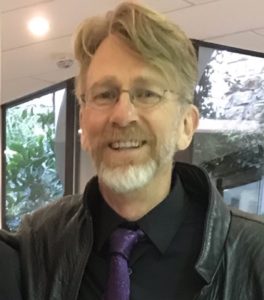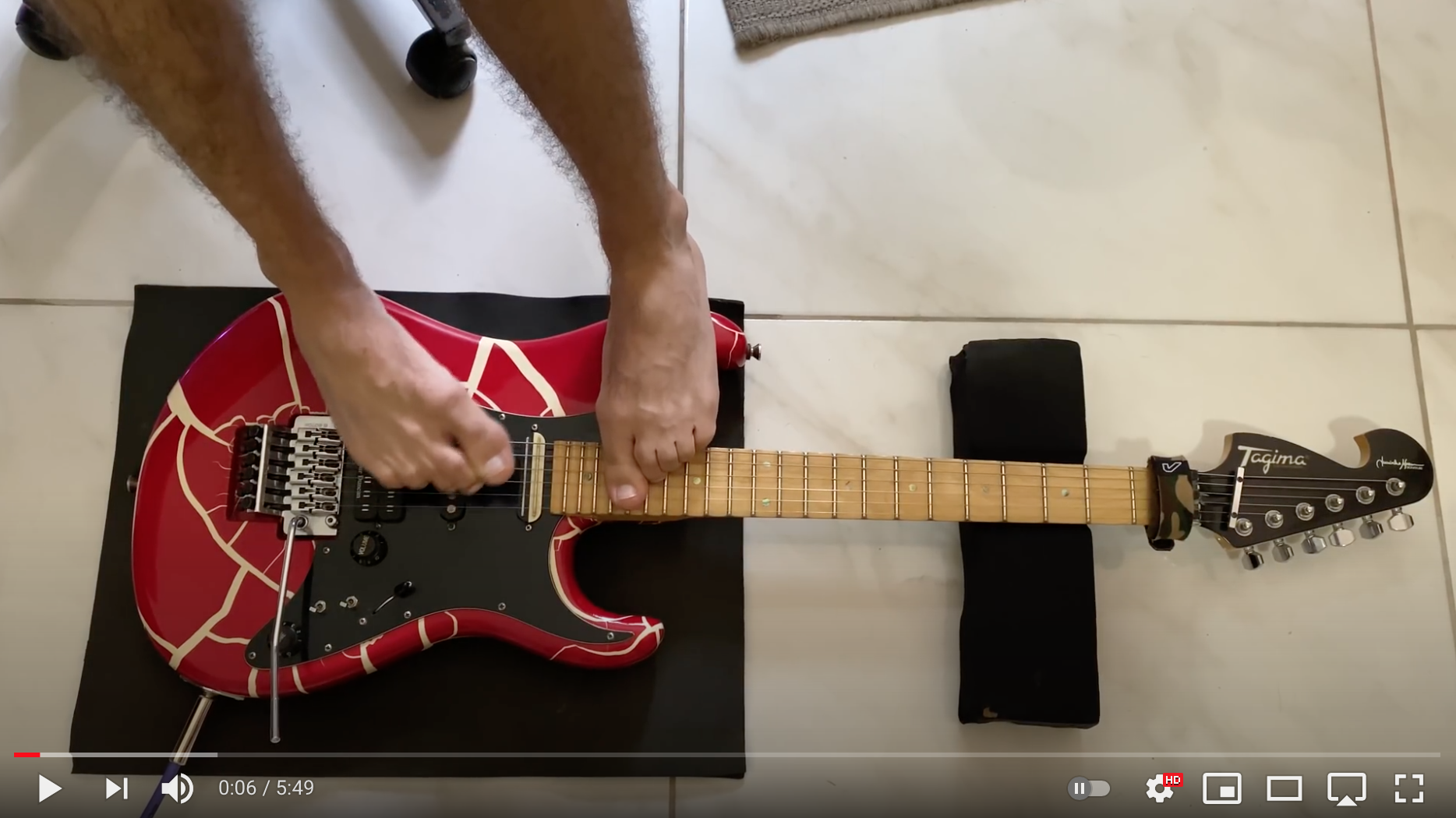By Al Wadleigh
That headline caught my attention when it came through my LoudWire feed the other day. Move over, Slash! Meet Johnatha Bastos, a Brazilian guitarist who plays solely with his feet. Johnatha was born without arms and hands, and he can play the guitar with the speed, grace, and ease of anyone who does have arms and hands.
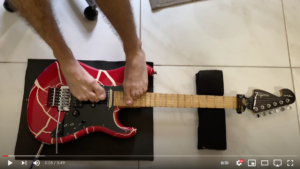
How is this possible? Because Johnatha was born without hands, all the cortical real estate that would typically be allocated to the use of the arms and hands reallocated to his feet instead.
This cortical real estate resides in the motor cortex of your brain. It is the part of your brain from which movement originates. There is a representation, or map, of yourself — your body parts — in the motor cortex.
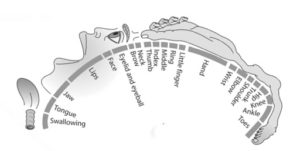
This brain map in the motor cortex is formed by use. In our early development, billions of neuronal connections are being made as we learn to interact with the world around us. Our first interactions with the environment and our caregivers are through our lips, tongue, and hands. As the brain map forms, so do our abilities.
The brain map is what Dr. Feldenkrais referred to as the “Self-Image.” It’s not an exact proportional image of your body. The use and diversity of function define it. You can see in the image below that the mouth, lips, tongue, and hand are disproportionately large compared to the arms, legs, and torso. We use the mouth for multiple tasks like eating, speaking, smiling, and kissing. The hands also have many functions like writing, feeding ourselves, affection, and using tools. Like this, we see them more primarily represented in the motor cortex.
The above image is a generalization and isn’t static. It is constantly changing based on what you have been doing. There is also a difference between the two hemispheres. The right motor cortex runs the left side of yourself. The left motor cortex runs the right side of yourself. For example, the dominant hand will have a larger representation in the brain and the thumb, particularly, will be more prominent than the other fingers than that of the non-dominant hand.
You will find differences from person to person because we are all different and have unique interests and movement habits. Take Steve Via, for example, a guitar virtuoso. If we were to examine his right motor cortex, we would find a much larger representation of his left hand — particularly the middle, ring, and small fingers — than in the average person or average guitar player.
Now, because Johnatha used his feet like hands, we can imagine his brain map may have developed like in the following image. (Please excuse my poor image editing. You get the idea.) With the foot and its toes much more prominent in their representation. Like the fingers are in a normally handed person.
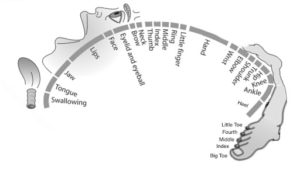
What Johnatha shows us is that we can have great dexterity, articulate movements, and impressive talent using our feet. The feet and the hands are very similar in structure. Each hand has 27 bones and 27 joints, and each foot has 26 bones and 33 joints. The feet, like the hands, are very sensitive. The limitations in our feet are not structural but are a limitation in the brain.

I’m not suggesting we all start playing the guitar with our feet. But we can improve the use of our feet. Most people only access a tiny fraction of their foot potential.
We encase the feet in shoes from an early age. Which means we don’t learn to move most of the joints in the feet.
“Since childhood, we interfere with the movement [of the feet]. We put shoes on. We do everything possible so the foot will not be able to move.”
– Dr. Feldenkrais, Alexander Yanai lesson 176, Turning in the Heels Part 2.
The consequence is that, over time, the rest of the self suffers. Other joints and muscle groups have to work harder to compensate for the limitations in the feet. This can lead to knee, hip, and lower back pain and many other issues.
I work with a lot of older adults in my practice. I have seen all kinds of foot, ankle, knee, hip, lower back, and many other issues resolved by improving the feet. Many of them wear orthotics as prescribed by a podiatrist when they start working with me. They are usually committed to wearing them. I never tell people to stop using them. That needs to be their decision. And most people eventually come to the conclusion that they don’t need orthotics.
It usually goes something like this. We’ve been working together for some time. My client is feeling better and moving better. Eventually, something happens like they put on a different pair of shoes or their shoes wear out, and they hesitate to buy another pair of orthotics because they are expensive. So they go without them, and they find they don’t need them anymore.
Their organization has changed in such a fundamental way they no longer need orthotics. They start wearing other shoes, and they don’t have the pain they used to have.
“You will see that all the members [all the parts of the body] come back to life with great speed if [you] give them [the feet] ability.”
– Dr. Feldenkrais, Alexander Yanai lesson, 192 Heels #2
My foot journey
Around 2007 I had developed significant foot pain. At this point, I am a few years out of my Feldenkrais Professional training. I admit, like most people, I hadn’t paid that much attention to my feet until the second joint of my right big toe started hurting.
I realized that because of my development and decades of improper self-use, I had a habit of ‘clenching’ my big toe when I stood and walked, which caused compression on the joint and eventually caused bone growth to form. It hurt like hell.
I knew from my Feldenkrais training about the potential my feet had for movement and my brain for learning. I knew there was a solution for me.
When relatives were visiting, we took a trip to Estes Park, Colorado. We were in the Plum Creek Shoe Store where I saw a pair of Vibram Five-Finger shoes. I think what the hell are these? They are like gloves for the feet!

I knew from my training that these crazy-looking shoes would differentiate my toes, allow all the bones and joints in my feet to move, and give me a clearer sense of the surfaces upon which I walk.
So I tried them on. I fumbled around, getting my toes in each pocket. And once I did, they felt sooooo good. It was like my feet had been asleep my entire life and had just awakened to a new world of improved function and sensation.
My foot pain resolved almost immediately. I wear them everywhere in all weather and environmental conditions. My feet feel great.
As my client’s movement, organization, and foot health improve, I will gently nudge them in the direction of trying the Vibram Five-Finger shoes. Those that try them often love them, especially for gardening and walking. I’ve had a few clients who eventually adapted them for their primary footwear.
You don’t have to go that far with your footwear. But you can take a step in a new direction for your foot health.
Here are a few simple things you can do:
- Do Feldenkrais lessons. Join a class or work with a Feldenkrais Practitioner. You can search Feldenkrais.com for a practitioner in your area.
- Download audio lessons to do in the comfort of your home. Many practitioners are offering recorded lessons for download. I sell many on my site (see my special offer in the Resource section).
- Be mindful as you walk and sense your feet. Go barefoot and expose your feet to different environments and temperatures. Walk on the carpet, wood floor, vinyl floor, and tile floor. Take your time to feel and appreciate the differences in the sensations. If you feel safe, go barefoot outside. Feel the differences in the feelings and temperature of the grass, cement, stone, etc. Mindfulness like this combined with the new awareness will help stimulate your feet and wake them up.
- Treat your feet. Soak them in Epsom salts or magnesium flakes. Massage them with magnesium oil or a CBD lotion.
Take care of your feet. Treat them well. And like Dr. Feldenkrais said, when you improve the ability of your feet, your whole body will come back to life and move with ease and comfort.
About Al:
Al Wadleigh is a Guild Certified Feldenkrais Practitioner based in Longmont, Colorado, for over 20 years. Al is deeply passionate about the Feldenkrais Method®. He owns The Feldenkrais Store, one of the largest collections of Feldenkrais audio, books and videos. He co-hosts the Feldenkrais for Life Podcast with Donna Ray. He is the publisher of the books by Dr. Feldenkrais: Hadaka-Jime (Practical Unarmed Combat) and Thinking and Doing. Al has taught thousands of classes and individual Functional Integration® lessons. His background includes immersion in Neuro-Linguistic Programming (NLP) and Ericksonian Hypnosis. His website is AchievingExcellence.com
